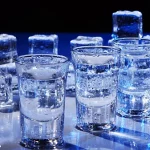Liqueurs
Among some of the oldest spirits, liqueurs are made from a base alcohol that’s distilled or macerated with various ingredients and then sweetened. In general, liqueurs make up to 35 percent sugar by volume, and crème liqueurs such as crème de menthe make up to 40 percent sugar. A liqueur can be herbal (Chartreuse), citrus- or fruit-based (Cointreau), floral (violet-inflected parfait amour), or nut- or seed-based (nocino, made from unripe green walnuts).







